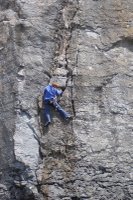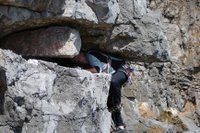Chris and I had tried to climb in Pembroke a few years ago but got skunked by MOD (Ministry of Defense) closures that put the entire area off-limits. We listened to tanks fire and watched helicopters shoot missiles at a buoy in the sea—all very interesting, but no climbing. Someone later told me, "Well you can always climb at St. Govans," but that's not true: Sometimes even the road to St. Govans is closed. This time, the red flag that indicates military firing was flying all week, but the road to St. Govans was open, and at last we got to sample some Pembrokeshire limestone. It was every bit as good as I'd hoped: steep, solid limestone, just as tricky as bolted sport climbs, but with no bolts. You place your own gear, and the complexity and the pump add significantly to the difficulty. We had only a couple of hours our first day, and we did a fantastic moderate route and then I got bouted on The Butcher, an overhanging arete that Chris followed flawlessly.
This time, the red flag that indicates military firing was flying all week, but the road to St. Govans was open, and at last we got to sample some Pembrokeshire limestone. It was every bit as good as I'd hoped: steep, solid limestone, just as tricky as bolted sport climbs, but with no bolts. You place your own gear, and the complexity and the pump add significantly to the difficulty. We had only a couple of hours our first day, and we did a fantastic moderate route and then I got bouted on The Butcher, an overhanging arete that Chris followed flawlessly. After all the beautiful sunshine we'd experienced in Britain this trip, we had begun to think it might never rain, but then it did and we had to take a few days off from climbing to hike around the headlands near St. David and explore the amazing cathedral there. When the rain stopped, finding the climbs by St. David proved a challenge. After an abortive mission to locate a sandstone cliff called Carreg-y-Barcud one evening, I broke down and bought yet another guidebook (my third for this trip), a two-volume behemoth that weighed about 1 pound and cost nearly 25 pounds (around $45).
After all the beautiful sunshine we'd experienced in Britain this trip, we had begun to think it might never rain, but then it did and we had to take a few days off from climbing to hike around the headlands near St. David and explore the amazing cathedral there. When the rain stopped, finding the climbs by St. David proved a challenge. After an abortive mission to locate a sandstone cliff called Carreg-y-Barcud one evening, I broke down and bought yet another guidebook (my third for this trip), a two-volume behemoth that weighed about 1 pound and cost nearly 25 pounds (around $45).  Thus armed, we easily located the short solid crags of Porthclais, where we topropoed a few routes above the incoming tide, and then, after a break for tea and a thunderous downpour, Chris and I walked back to the steep slabs of Carreg-y-Barcud and did a terrific crack climb before dinner. That was $45 well-spent. I guess.
Thus armed, we easily located the short solid crags of Porthclais, where we topropoed a few routes above the incoming tide, and then, after a break for tea and a thunderous downpour, Chris and I walked back to the steep slabs of Carreg-y-Barcud and did a terrific crack climb before dinner. That was $45 well-spent. I guess. As at every cliff we visited during this trip, none of these seacliffs had anchors at the top. That meant building anchors in boulders and outcrops, or, in many cases, trusting our lives to steel stakes or rebar driven into the turf and tied off. This was a bit hard to take at first, but you quickly get used to it. Even though they flexed a bit, the stakes seemed secure, and some even had an eye for clipping in. In any case, they had to be stronger than the stake anchors some British friends and I used years ago when we climbed the chalk cliffs in Dover: aluminum shelf brackets nicked from the store where we all worked.
As at every cliff we visited during this trip, none of these seacliffs had anchors at the top. That meant building anchors in boulders and outcrops, or, in many cases, trusting our lives to steel stakes or rebar driven into the turf and tied off. This was a bit hard to take at first, but you quickly get used to it. Even though they flexed a bit, the stakes seemed secure, and some even had an eye for clipping in. In any case, they had to be stronger than the stake anchors some British friends and I used years ago when we climbed the chalk cliffs in Dover: aluminum shelf brackets nicked from the store where we all worked.  For our last day of climbing, we headed back to St. Govans—our first return visit to a crag on this entire trip. (In all, we climbed at 8 crags in 8 days of climbing.) It was a gorgeous day, and it was pure pleasure to have the place already dialed.
For our last day of climbing, we headed back to St. Govans—our first return visit to a crag on this entire trip. (In all, we climbed at 8 crags in 8 days of climbing.) It was a gorgeous day, and it was pure pleasure to have the place already dialed.  No searching for the right road, the right path, the right cliff-top, the right rappel anchor, the right route. We fixed a spare rope to a stake and then rappeled back to the beach after each route, bang, bang, bang, climb after beautiful climb. Chris and I agreed that The Arrow, a varied, steep, solid 5.10a might just be the best single-pitch route we'd ever done. And with graceful moves like this head-first jacknife body squeeze, who wouldn't love the 5.9 prow called Front Line?
No searching for the right road, the right path, the right cliff-top, the right rappel anchor, the right route. We fixed a spare rope to a stake and then rappeled back to the beach after each route, bang, bang, bang, climb after beautiful climb. Chris and I agreed that The Arrow, a varied, steep, solid 5.10a might just be the best single-pitch route we'd ever done. And with graceful moves like this head-first jacknife body squeeze, who wouldn't love the 5.9 prow called Front Line?
After three previous visits to Britain in a row characerized by cold rain and gale-force winds, it was a treat to experience the beautiful long northern days in all their summer splendor. I know we'll be back.
Wednesday, August 02, 2006
My British Vacation IV: Pembroke
Posted by
Dougald MacDonald
at
6:16 PM
![]()
![]()
Subscribe to:
Post Comments (Atom)








No comments:
Post a Comment